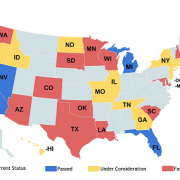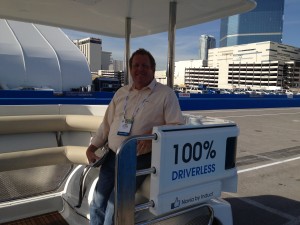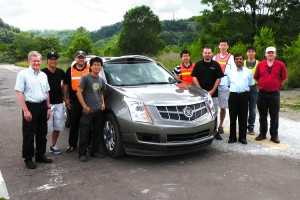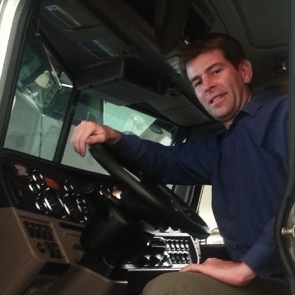Posts
Three States Approve Autonomous Vehicle Legislation
/1 Comment/in Article, Government, Industry, LegalBurney Simpson
Three states this year enacted legislation to advance autonomous or connected vehicles, while legislators in nine states are still considering such proposals.
North Dakota approved a plan that would allow the testing of autonomous vehicles. Tennessee banned its counties and cities from banning autonomous vehicles as long as they are as safe as standard vehicles. Utah will conduct tests on connected vehicles.
One solid source for state legislation related to driverless transportation is a website maintained by the Stanford Center for Internet and Society. The pages on Legislative and Regulatory Action follow these developments and provide links to pertinent proposals. However, updates to the site can be slow. (The graphic here is the Center’s latest map tracking developments).
It is difficult to predict whether any of the nine states still considering proposals will pass anything. In state legislatures, proposals shunted off to a committee typically expire. However, it is not unknown that a proposal sitting in a committee for months will suddenly be revived, passed, and signed by the governor.
When monitoring state legislation — never count on anything, nor count anything out.
According to the Center’s updates, the following states took the lead on autonomous-vehicle legislation during their recent sessions:
Connecticut – Rep. Christie M. Carpino, a Republican from Cromwell, Portland, is the sponsor of HB 6344, a proposal that would allow the testing of autonomous vehicles. It has been stuck in committee for months.
Georgia – SB 113 is sponsored by Sen. Joshua McKoon, a Republican from Columbus. This proposal would create a new class of autonomous vehicles and allow for their testing on public roads. The bill passed through committee but has been hanging around the Senate since February.
Idaho – The Senate in March approved by a one-vote margin S1108 that would allow for the testing of autonomous vehicles on public roads. It was sent to the House and hasn’t been heard from since. Sen. Bert Brackett, a Republican from Rogerson, sponsored the bill.
Illinois – The House in April passed unanimously HB 3136, a proposal allowing the testing of autonomous cars on public roads. The legislation must be passed by the full Senate where it is sponsored by Sen. Martin A. Sandoval, a Democrat from Cicero. This one may still have a chance.
Massachusetts – House Bill 2977 creates some definitions for autonomous vehicles, and allows for their testing on public roads. Sponsor is Rep. Peter J. Durant, a Republican from Spencer. Nothing has happened on this one since January when it was sent to the Joint Committee on Transportation.
Missouri – Rep. Delus Johnson is sponsoring HB 924 that would allow testing of driverless vehicles for three years beginning this August. Nothing shaking here since a March committee hearing.
New Jersey – The Senate passed S734 that would direct the state Motor Vehicle Commission to set rules for the operation of autonomous vehicles. The House may consider twin bill A1326 before it adjourns.
New York – Proposal A31 is sitting in the Transportation Committee of the New York Assembly. Sponsor Rep. David F. Gantt, a Democrat from Rochester, wants to allow the testing of autonomous vehicles.
North Dakota – Legislators approved a measure to study automated vehicles, and Gov. Jack Dalrymple signed it on March 20.
Oregon – A proposal in the Senate would create a process to certify manufacturers to test, sell, and operate autonomous vehicles in Oregon. Sen. Sara Gelser, a Democrat from Corvallis is the chief sponsor of SB 620, which is sitting in the Business and Transportation Committee.
Tennessee – Gov. Bill Haslam signed into law in April a bill that prohibits any political body in the state from prohibiting autonomous vehicles if the vehicles meet all the state’s safety regulations.
Utah – Gov. Gary Herbert signed in March a bill authorizing the state Department of Transportation to conduct a test of connected vehicle technology.
A Maryland proposal that once looked promising was shot down before crossing the finish line. The House wanted to spend $200,000 to study autonomous vehicles but a Senate committee said no as the state looks to cut spending.
At this time only California, Florida, Michigan, Nevada and the District of Columbia have passed legislation allowing for the operation of autonomous vehicles. The National Highway Transportation Safety Administration has issued regulation guidelines on the topic for states.
Short Term Predictions
/0 Comments/in ArticleDarcy Conlin
Driverless cars are sure to revolutionize society as we know it. We at DriverlessTransportation.com are excited about the changes that will come from this new technology, and we believe that nearly every single person’s life will be impacted by this technology.
It’s particularly interesting to actually envision a world without drivers. What will it look like? What will it sound like? How will my everyday routine change? In addition, it’s interesting to think about the trajectory of this industry as a whole, and what will happen with time. At the bottom half of this page you will find what we thought might happen a year ago and the actual results.
As far as where we stand today, we wanted to again make our own predictions about what we see happening in the next year (or so). These are listed below. We cast short-term predictions about the technology, the business, the societal impact, and the legal ramifications that come with the introduction of driverless transportation.
If you’re interested, leave a comment with your own predictions. We’ll look back around this time next year and evaluate the outcomes.
Rick:
- There will be a sanctioned race between driverless cars on a closed racetrack where the winning average speed will be greater than 100 mph.
- DSRC Radio vendors will offer complete chip sets at quantities or 1MM plus for less than $25/unit
- The number of “test” cars with DSCR Radios broadcasting Basic Safety Messages (BSMs) in the US will be greater than 25,000 by the end of 2015
John:
- There will be actual platooning done with commercial vehicles. This will be on actual roads and not just test cases.
- A commercial company will announce a pilot program to begin in 2016 using driverless cars with real customers on regular roads.
- Microsoft or Apple will announce a new program, in conjunction with an Automotive OEM, to begin building a driverless car.
Manuel:
- Driverless technology knock offs will come out of China.
- Government legislation will be passed to control testing of driverless technologies prior to roll out.
- Cyber vulnerabilities will be discovered in existing SCATA systems (charging stations, update platforms).
Burney:
- I will attend a major transportation show and report on the event for Driverless Transportation.
- Google will partner with an international auto manufacturer in 2015 to advance driverless technology.
- The D20 Stock Index will top 150 before the end of the second quarter of 2015.
Collin:
- The 2015 Detroit Auto show will be looked back on as a pivotal moment for the development and acceptance of driverless cars/transport
- An “A-list” celebrity will publicly endorse driverless transportation on twitter or other social media causing a spike in interest
- This year’s superbowl will feature driverless transportation of some sort on the field during warm-ups/pre-game
Stephen:
- A major planned development including all driverless vehicles will be announced — but not in the United States. (My money is on UAE, but don’t count out Qatar, Kuwait, South Korea, or China.) Google will not be the technology partner.
- Driverless cars will push further into mainstream consciousness with an appearance on The Simpsons or Family Guy.
- Carnegie Mellon’s CHIMP team will win the DARPA Robotics Challenge in Pomona, CA this June. In the course of victory, CHIMP will become the first robot to drive a vehicle.
Giselle:
- Toyota will change it’s mind and will start developing autonomous vehicles
- Mercedes’ driverless cars will be more popular than Google’s because they will still be made with a steering wheel and pedals
- “Robo-ethics” will slow the progress of driverless transportation. For example, when faced with a dangerous collision, should the autonomous car be programmed to act in a way that will save it’s passenger(s) or to save as many lives as possible even if this means killing it’s own passenger(s)?
Amy:
- At least 4 other states will allow driverless cars on their roads.
- BMW takes their parking assist technology to the next level with a fully self-driving vehicle in the U.S.
- Google designs a more practical, advanced driverless prototype.
Darcy:
- Iowa along with one additional state will pass a bill allowing driverless vehicles on roads.
- USDOT will standardize the screen size display of communication platforms within AVs.
- Obama and First Lady Michelle will drive in an autonomous vehicle.
At the end of 2013, each member of the team listed a set of predictions for the coming year. Here they are again and an analysis of how we did.
Rick: Total score: 0.5.
- Google hits a Million Miles on its driverless fleet. - Probably close but not quite.
In April Google announced 700,000 miles on its cars. August, 2012 announced 300,000. Which means they were on a 20k per month pace. Probably have more vehicles but have been concentrating more on in-town driving (which means less miles). Have to say no to this one.
- Tesla announces a schedule for driverless vehicle before 2018. -
Depends on how tightly we define this. Give 1/2.
- One of the major Automakers (other than Toyota) announces a significant Partnership with Google.
Not for driverless. No points
John: Total Points: 1.5
- A driverless car will have an accident.
Based upon this article, John tried to argue Yes but we’re not going to give him the points - Zero points.
- A bill to allow driverless cars will be initiated in Virginia (and 3 other states).
He shouldn’t have said Virginia. But a number of other states such as Maryland, New Jersey and Louisiana have initiated bills. 1/2 point.
- Tesla and Google will announce that they are working together.
Didn’t happen - No Points.
Did happen. We even have a picture.
Manuel: Total score: 1.5 points.
- Major players in driverless technologies will turn to military contractors to harden and protect their systems from cyber attacks.
The industry didn’t move far enough for this. Zero points.
- Government legislation will step in again and fund the automotive industry supporting driverless transportation citing employment (job development) as its primary goal.
Haven’t see the job development but there is major funding. 1/2 point.
- One of the major computing hardware companies will develop a new system of systems backplane allowing the automotive industry to standardize how driverless technologies will be implemented.
We are seeing this the basics of this from both NVIDIA and Harbrick. 1 point.
- Legislation will be passed that endorses and legalizes only one of the driverless technologies.
This didn’t happen - 0.
Shawn: Total score: 1 point.
- Two driverless cars will crash and the occupants will want to sue. This will spark a public legal issue of who is liable when no one is driving. - Was a bit premature for this.
- An article on Driverless Transportation will make the front page of the Washington Post and/or a segment on 60 Minutes. Did happen.
- I will see someone riding in a driverless car at Stanford.
Didn’t happen. Perhaps Shawn should have gotten off campus more.
Guess it paid to give 4 predictions! This year we limited it to 3 per person.
A Millennial’s Perspective on Driverless
/1 Comment/in Article, Future, Impact, Technology, TransportationSteve Feyer
For most of our adult lives, the millennial generation has been hearing about the promise of driverless cars. While other technology changes took place behind a screen, this revolution promises to change our lives in the real world.
This revolution promises to have a great impact on the lives of those under the age of 35, yet most commentary focuses on the opinions of political leaders, business people, and researchers who are much older. How do young adults view the coming of driverless cars?
In this series of two articles, Driverless Transportation interviewed Americans under the age of 35 about their opinions on driverless cars, seeking to understand how they hoped to benefit, and what they thought they would lose, as this technology is deployed.
In the first installment, we spoke with ten millennials working in the autonomous vehicle field. The panel included scientists, public policy experts, and engineers educated at top programs such as Carnegie Mellon University, Stanford and MIT. Interviewees included current students, entrepreneurs, researchers, and professors.
The majority of those interviewed said they still see fully driverless cars as far off. More than half thought the technology will not appear on roadways until 2030 or later. Only one thought a NHTSA Level 4 vehicle would appear in as little as six years.
Yet Google unveiled such a prototype just this past summer, so why the skepticism?
“One of the major reasons is the lack of trust in the technology,” said a current Carnegie Mellon computer science student. “Right now, some people still believe that they can make a better decision than a computer or driverless car can, despite some pretty overwhelming statistics [to the contrary].”
With their deep knowledge of the technology involved, some doubted the promise of totally automated driving.
“I don’t know if we’ll ever get to a point where a car can work its way out of any situation,” said one policy expert.
Another expert commented, “I do not think I can afford a driverless car in Level 4 in my life.”
Much coverage of driverless car technology focuses on the possibilities, but the most informed are more focused on the difficulty of engineering a car that can handle the full range of driving situations. Given this challenge, the panelists expressed more confidence in lower levels of automation for more routine driving tasks, such as auto valet and highway autopilot.
Although Google is best known for bringing driverless cars into the public eye, perhaps surprisingly, only one of these young experts thought Google would be the first to bring a driverless car to market.
“Despite the excitement over the Google car, they are not going to be the ones who sell you one of these things,” one inventor declared confidently. “Their goal is to push other companies to this market faster.”
Most thought the incumbent automakers would win the race to autonomy, specifically pointing to the German automakers and suppliers as the innovators.
“The German companies have been in this area for longer and, in my opinion, currently have the superior solutions,” said one young researcher.
Nissan and Tesla also received several votes of confidence, Nissan because of its aggressive public statements and Tesla for its level of inventiveness in a short history.
“Nissan/Infiniti seems to be making a larger bet than most on the technology,” said an engineer who builds autonomous vehicles. “Tesla and Google will definitely factor in, but I don’t know if they have the leverage to affect the majority of the auto market.”
No matter which companies are first, the technology still faces a formidable range of challenges. When prompted to discuss the main barrier to fully driverless cars, each expert talked about a different problem. The concerns fell into three general categories: technology, consumer trust and liability.
A host of unsolved technology problems occupy the experts. “Will standards be determined by a government entity or will it be an industry consortium?” asked one entrepreneur. An engineer commented on the stubbornly high cost of effective sensors. Another company founder wondered how current map-based approaches could be cost-effective: “Can they afford to test with professional drivers for all those vehicle miles traveled until they certify each software change?”
Despite the extraordinary advances of recent years, the consensus appears to be that the technology must pass many more hurdles to be ready for the mass market.
Other comments focused on consumer perception of driverless cars, with one engineer flatly declaring that most drivers will never allow their cars to take over for them.
A policy researcher asked an important question about maintenance: “On just about every corner in the U.S. you can find a mechanic who will change your oil. But how many people will be qualified to make sure the software is up-to-date and running correctly?”
Several interviewees mentioned the issue of liability, perceiving that driverless cars threaten the insurance industry’s existing business models. An engineering masters student illustrated the problem: “At the announcement of Google’s driverless car, Warren Buffett said this is the one of the worst things to affect the American economy. He happens to own a major share in Geico and he knows this would be a hit to the insurance industry.” Most who spoke about this concern, however, declared it solvable in time.
Once the issues with technology and marketing are addressed, driverless cars will raise other challenges that these young leaders hope to address. Several interviewees went into detail about traffic and access to transportation.
Avi Mersky, a Carnegie Mellon PhD student, is troubled by the potential impact on mass transit and road usage.
“Even if society subsidizes personal autonomous vehicle usage, such that all can afford it, the efficiency loss in terms of space needed for transportation and energy usage can be expected to be quite large,” Mersky explained. “If society doesn’t provide such subsidies, then much of society could find its access to transport greatly degraded. This would lead to severe costs, not just on individuals, but society as a whole.”
More optimistically, a different policy researcher suggested that “a mobility-on-demand system can make taxi systems cheaper and more efficient, and can be used to address the first and last mile problem that can make public transportation so much more tedious.”
Some published estimates have suggested a fleet of fully driverless cars could be 90 percent smaller, in theory lessening congestion, but those who are closest to the problem are not confident in this prediction.
“There’s the very real possibility that autonomous vehicles will only make traffic and congestion worse,” the policy researcher continued. “The media focuses on the hype that autonomous vehicles are going to solve all our traffic problems.”
The panelists suggested three factors that could cause driverless cars to worsen congestion. Vehicles could be programmed to be so conservative that they increase following distance and stopping times. A lack of V2V communication standards could cause vehicles not to coordinate with each other. Finally, if the cost of time spent in the car is lower, people may choose to spend much more time in vehicles – perhaps even living out of them in great numbers.
Concluded one professor, driverless cars “will change the way people commute and travel, change people’s daily schedule and life style, and our traffic in the next few decades will look very different from today.”
Whether this change is a boon remains to be seen.
While they work on different facets of driverless transportation, these rising leaders have suggested that traffic management is the most uncertain and difficult problem. The driverless future may not materialize unless autonomous cars are more convenient than today’s cars.
One could conclude from these interesting conversations that the twin issues of transit and congestion urgently need the energy and insight of the next wave of emerging world-changers.
Our young leaders had much more to say. In our second installment about the millennial view of driverless cars, we will compare the thoughts of these innovators with the opinions of twenty-somethings who work outside the field.
 Steve Feyer is a James R. Swartz Entrepreneurial Fellow and MBA at Carnegie Mellon University’s Tepper School of Business.
Steve Feyer is a James R. Swartz Entrepreneurial Fellow and MBA at Carnegie Mellon University’s Tepper School of Business.
Platooning Takes to the Road
/1 Comment/in Article, Economics, Future, Impact, Industry, Technology, TransportationDarcy Conlin
This featured article looks at Peloton Technology Inc., a Menlo Park, California-based automated vehicle technology company focused on developing a system to reduce fuel consumption and improve the safety of trucks by using advanced sensing and communications. The word “pelotón” is Spanish for platoon — and platooning of trucks is precisely what Peloton Technology intends to foster. Dr. Josh Switkes is the CEO of Peloton and holds a PhD from Stanford University in Mechanical Engineering. After hearing Switkes speak at ITS CA in October, Driverless Transportation wanted to learn more about the company and what Peloton is doing within the industry.
Peloton has a team of 11 employees poised to rapidly growing as they work to develop their technology and deploy production systems in 2015. The company was formed in 2011 with the goal of creating a system that would allow pairs of trucks to share information on their braking and engine systems to help them travel more safely and save fuel. The team began conducting market research in 2011, building on many years of experience across the founding team. The four members of the founding team come from backgrounds in the automotive and truck industry, vehicle safety and dynamics, business development, public affairs and government. Switkes has been working on systems to make driving safer and more efficient for the last 12 years. After his PhD work at Stanford University on a vehicle control systems, including guaranteeing safety for lanekeeping assistance and steering wheel haptic feedback, Switkes developed production control systems for Volkswagen, Audi, and Tula Technology. Peloton’s Principal Scientist Chris Gerdes is also a Professor at Stanford and the Director of the Center for Automotive Research at Stanford (CARS). Prior to joining Stanford, Gerdes was the project leader for vehicle dynamics at the Vehicle Systems Technology Center of Daimler-Benz Research and Technology North America. In this role, he worked closely with Freightliner / Daimler Trucks North America. Peloton’s VP Product, Dave Lyons has decades of experience with Silicon Valley technology startups and worked for many years as a leader at IDEO. Among other work in the automotive space, Lyons was employee #12 at Tesla where he led the development of the Tesla Roadster. Steve Boyd, Peloton’s VP External Affairs, has over 20 years of experience in government, public affairs and business development, including serving as a White House assistant press secretary, a PBS Newshour reporter/producer and in business development for a range of technology companies. Peloton is funded by a mixture of angel investors and venture capital investors including Castrol innoVentures which is part of British Petroleum.
The trucking industry handles about 70% of the freight in the US. This makes trucking a vital part of the US economy. Dr. Switkes noted there is a saying in the trucking industry that “If you bought it, a truck brought it.” To be clear, Peloton is not about either driverless or autonomous trucks. Drivers are an integral part of the Peloton System. The system simply augments driver performance and safety and leverages the cooperative potential between pairs of trucks.
How does the system work? It is geared for tractor-trailers operating on multi-lane divided highways and it’s important to note that even when the trucks are safely linked, both drivers continue to steer and the role of first driver isn’t much different from today. The system adds forward collision mitigation radar to each truck making individual trucks safer while on their own. Using vehicle to vehicle (V2V) communications, these active safety systems are linked between pairs of trucks when they form up into a platoon. While out on the road, trucks that utilize the Peloton System will be notified by the Network Operation Center (NOC)[1] that they are coming into range of each other and can link up. The NOC helps trucks find each other on the road by identifying platooning opportunities so if Peloton equipped trucks are within V2V range, one truck can slow down and one can speed up in order to rendezvous.
The NOC is an Internet based cloud service that each truck connects to via either a cellular or Wi-Fi link. The NOC is separate from the V2V communication and is used to make sure the trucks are platooning only when it is safe to do so. These trucks are connecting on interstates and major highways, not residential areas. The NOC can also remotely adjust the following distance of the platoon for weather, traffic or other road conditions. The Peloton System shares much more than just the braking information between the trucks. Additionally, engine torque, acceleration and speed data is shared. Most importantly, forward collision mitigation radar and other active safety system data is shared between each pair of trucks increasing safety when they are in platoon. So whether the front truck is slowing down due to braking, a hill, a tire blow-out, or upcoming slower traffic, the information is instantaneously shared allowing the rear truck to react smoothly and immediately.
The key safety benefit comes from this assurance that the rear truck will react through V2V communication at the same time as the front truck. This essentially guarantees simultaneous braking between the two trucks. In a best-case scenario where a driver is operating manually, human reaction time ranges from 1-2 seconds even for a good driver. Peloton guarantees that every single time, even if the driver is distracted or has trouble seeing (for example the sun is in their eyes or it’s foggy) the system will react dramatically faster than an attentive human driver would under normal conditions. While a 1-2 second reaction time may not seem like much, at high speeds it definitely can be the difference between having an accident or not.
The biggest and most frequent accidents within the trucking industry are caused by frontal collisions. The brakes on most heavy trucks don’t react quickly because they use air brakes. With air brakes, there’s what is called a “brake lag” from the time the brakes are applied to when the truck actually begins to slow down. The Peloton System virtually eliminates that lag in paired trucks by using the V2V communication to apply the brakes in the rear truck at virtually the same time they are applied in the front truck. Switkes said, “We are not reacting to the front truck slowing down, we are reacting to the front truck applying its brakes. That can be the difference between safely braking and having an accident. In many cases we are actually applying the brakes in the rear truck before the front truck has started to slow down, because we are reacting to the application of brakes, as opposed to the actual slowing down.”
Peloton also increases safety by enhancing drivers’ awareness of what’s going on around each of the connected vehicles. Video is sent between the two trucks. There is a forward facing camera on each truck and video is sent so the driver of the rear truck gets the view from the perspective of the front truck. Therefore the rear truck can see what’s ahead on the road such as cars coming in on the shoulder from an on ramp. There are screens within the trucks cab that show the driver these views, mounted similarly to a rear-view mirror. Additionally, the video feed that comes from a rear truck allows the front driver to get a view of his/her own truck from behind. This is extremely effective in showing blind spots. Blind spot accidents are another major type of accident for heavy trucks. Driving a 72-foot tractor-trailer makes it difficult to know if another vehicle is next to you. According to Switkes, the Peloton System will help prevent accidents caused by blind spots.
We mentioned the driver is still steering but what else do they need to know in order to operate their vehicle? Switkes underscores that driver training is a key part of the system. The first time the system is turned on it will show the driver what it feels like to be platooning at a far distance. Then it will demonstrate what it feels like to be closer and experience an automatic braking event, not a hard braking event. The goal is to make sure that the first time the brakes are applied automatically is not a safety critical situation. Peloton does not want any surprises for the driver. The training includes driving with the system so drivers get a strong understanding and feel for the system.
Besides the safety benefits that Peloton offers, dramatic fuel efficiency comes from the aerodynamics of bringing the trucks closer together. Within a typical trucking fleet, fuel is about 40% of the operating cost so when talk of saving fuel comes up, trucking companies do take note. Peloton worked with the North American Council for Freight Efficiency and the major trucking fleet CR England to test their system and measure fuel economy in November 2013. This independently validated study followed the industry standard SAE Type II testing procedures and showed 10% fuel savings on the rear truck and 4.5% on the front truck. The results of additional comprehensive track testing performed by the U.S. Department of Energy will be issued in the next few months. These levels of fuel savings are enormous given that a typical trucking company spends $80-$100 thousand a year on diesel fuel for each long-haul truck. It’s estimated that the average savings from platooning with the Peloton system will amount to approximately $6,500 per year for each typical long-haul truck.
The fact that the rear truck saves more on fuel would likely make every fleet want their trucks to always be in the rear position, unless the two trucks are owned by the same company. However, a key part of the Peloton System is that trucks are ordered based on weight and braking ability. If there is an emergency stop, Peloton wants to be assured that the truck with the longest stopping distance is in the front of the platoon. For a given pair of trucks, the truck with the best braking ability and shorter stopping distance will be in the rear — and will get the better aerodynamic fuel savings. So trucks with the best combination of relative weight and good brakes will get the rear following position — and better fuel savings. In the rare instance that the braking ability is identical, Peloton may allow switching order, but Switkes says that will be unusual. In most cases there will be some difference in braking ability and the trucks will be ordered appropriately. If two trucks within the same company are traveling together, the order obviously won’t matter since the savings is across the same company.
Peloton Technology plans to have initial deployment with fleets that can easily adjust to have multiple trucks together on the road. The general public may not notice that many corporate fleets already travel in groups on our highways. Fleets like UPS and FedEx roll out trucks from their hubs based on the timing of when they finish sorting packages. According to Switkes, “Some fleets are sending out multiple trucks every day and they have to tell the drivers to leave a couple of minutes apart so that they don’t get backed up together at a stop light before getting on the interstate. So fleets like this only need to change their operation by telling two trucks, instead of one, to leave every few minutes.” For those owner operators with just one truck, there is the incentive to buy trucks with better brakes to better ensure being in the preferred rear platooning position. Switkes told us that some of the OEMs are already talking about having special platooning equipped trucks with better brakes.
When will we see this in action? Peloton has already driven the system over 12,000 test miles across the west and southwest. Currently they are collecting and analyzing data in a ‘data pilot’ with the Tennessee-based fleet TCW. This pilot has sensors and cloud-based monitoring operating on two trucks that run close together, though not yet platooning, as they carry freight between Nashville and Memphis. This data pilot and others to follow soon will help inform fleets about the benefits of implementing platooning on major freight corridors and to demonstrate the system’s evolving telematics features. In Q1&2 2015, a series of major fleet pilots will get underway. The aim is to have full production systems ready for deployment by late 2015.
There are no obstacles at the federal level to inhibit Peloton from moving forward. NHTSA has no regulations that get in the way of platooning. However, at the state level, states have their own following distance (tailgating) laws and Switkes said there are some states where that law or related laws would seem to place limits on platooning. However, just as driving laws were not made with driverless operation in mind, following distance laws – some of which apply specifically for trucks – were not written when wirelessly-connected active safety systems were available. What Peloton has found is that states in the US understand the importance of trucking to their economy and are open to innovative ways to make their freight corridors safer and more efficient. Switkes says that they are working with the states that have limitations in their following distance laws to explain the issues at play and find solutions. The most important thing Switkes says on this is that “When we roll out our system on customer trucks, we will be absolutely sure that those trucks will NOT get pulled over for tailgating.”
The Peloton System will be offered as a usage-based managed service. Fleets will pay a one-time fee for System hardware and installation to equip trucks and then they will pay a per-mile fee when trucks are in platoon. A rapid payback period as quick as a few months is anticipated for typical long-haul trucks. Switkes has his Commercial Driver Learners permit and is on his way to getting his full license — so he won’t be on the road driving a Peloton-equipped truck just yet. However, he and his company are driving towards deploying V2V technology and truck platooning in a more concrete way than others in the industry. Things look positive for 2015.
[1] Peloton’s Network Operations Center (NOC) coordinates trucks to find linking partners on the road and enables cross-fleet platooning. Geo-fencing enables trucks to platoon only on appropriate roads (accounting for passing lanes, topography and other factors), in safe conditions, with safe drivers. (http://www.peloton-tech.com/about/)









